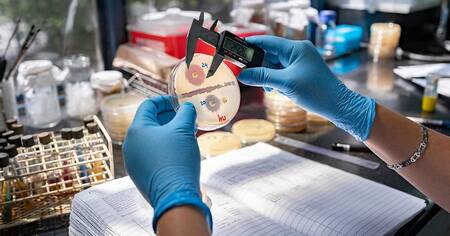InFARM System
Generating science-based evidence in food and agriculture sectors to tackle AMR
FAO is committed to establish and maintain a global system supporting national efforts to regularly generate and disseminate reliable AMR data in food and agriculture enabling monitoring and surveillance of AMR at national, regional, and global levels to inform evidence-based decisions.
One of the key elements for strengthening country capacities for surveillance and monitoring of antimicrobial resistance (AMR) and use (AMU) in food and agriculture is to provide a standardized approach for collecting, analyzing, interpreting, and sharing data.
What is the InFARM System?
The International FAO Antimicrobial Resistance Monitoring (InFARM) system consists of an IT platform and related FAO activities that assist countries in collecting, collating, analyzing, visualizing, and effectively utilizing their AMR monitoring and surveillance data primarily from livestock, fisheries, and aquaculture, along with their associated food products.
InFARM builds on prior collective experience and knowledge gained by FAO and Quadripartite organizations through the implementation of activities on surveillance capacity building. These include the deployment of the FAO Assessment Tool for Laboratories and AMR Surveillance Systems (ATLASS) and the extensive support on the development of national surveillance activities and programmes through the provision of guidelines and materials.
InFARM is expected to play a pivotal role in assisting countries that are willing to share their AMR data in animals and food for global surveillance. It will act as the bridge for integrating these data with information from the WHO Global Antimicrobial Resistance and Use Surveillance System (GLASS) and the WOAH ANImal antiMicrobial USE Global Database (ANIMUSE) into the Quadripartite Global Integrated System for Surveillance of Antimicrobial Resistance and Antimicrobial Usage (GISSA).
Data privacy will be guaranteed by providing users access to separate private and public interfaces with various levels of confidentiality for data sharing. Members enrolled in InFARM will have the possibility to share data in the private interface (only accessible to designated officials in the country) or to make data publicly available for the international community.

Resources
- FAO and WHO. 2023. Foodborne antimicrobial resistance – Compendium of Codex standards. First revision. Codex Alimentarius Commission. Rome.
- WOAH. 2024. Codes and Manuals: Terrestrial Animal Health Code, Chapter 6.8., Harmonization of national antimicrobial resistance monitoring and surveillance programmes; Aquatic Animal Health Code, Chapter 6.4., Development and harmonization of national antimicrobial resistance monitoring and surveillance programmes for aquatic animals; Terrestrial Manual of Diagnostic Tests and Vaccines for Terrestrial Animals, Chapter 2.1.1., Laboratory methodologies for bacterial antimicrobial susceptibility testing.
- FAO. 2019. Monitoring and surveillance of antimicrobial resistance in bacteria from healthy food animals intended for consumption. Regional Antimicrobial Resistance Monitoring and Surveillance Guidelines – Volume 1. FAO. Bangkok.
- FAO, NParks & SFA. 2023. Monitoring and surveillance of antimicrobial resistance in bacterial pathogens from aquaculture – Regional Guidelines for the Monitoring and Surveillance of Antimicrobial Resistance, Use and Residues in Food and Agriculture. Volume 3. Bangkok.
- FAO & WOAH. 2023. Guidelines on monitoring antimicrobial use at the farm level – Regional Guidelines for the Monitoring and Surveillance of Antimicrobial Resistance, Use and Residues in Food and Agriculture. Volume 5. Bangkok.
- FAO. 2024. Surveillance data of the Indian Network for Fishery and Animal Antimicrobial Resistance (INFAAR) – An analytical report 2019–2022. New Delhi.
- FAO, OIE, WHO. 2019. Monitoring and evaluation of the global action plan on antimicrobial resistance: framework and recommended indicators.

